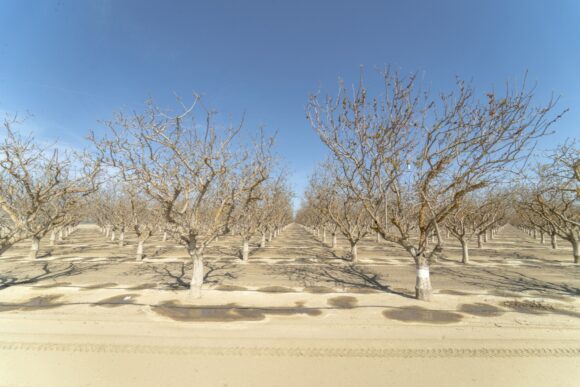There is dry, and then there is desiccated.
As any movie fan knows from the classic film Chinatown, California is an infamously thirsty place. But this year, even by its own standards, the state is shockingly, scarily parched. So far in 2021, the state has received half of its expected precipitation; that makes it the third driest year on record according to California’s Department of Water Resources.
This past week, as temperatures from Sacramento up to the Oregon border topped 100º Fahrenheit, the intense heat evaporated the remaining water at an astonishing pace, creating scenes more reminiscent of Hollywood-manufactured dystopias like Mad Max than the lush paradise Americans are used to envisioning on their West Coast.
At Folsom Lake, the enormous reservoir that supplies both drinking and irrigation water in the middle of the state, surface levels suddenly dropped to 68 feet below what they were at this time last year. By last week, boat slips that once floated were sitting on a dry lake bed with grass sprouting around them.
Folsom is hardly alone in its extremity. The long-lasting lack of precipitation is taxing reservoirs state-wide. On April 21, California Gov. Gavin Newsom declared a drought emergency in two northern counties, Mendocino and Sonoma, where water levels had reached record lows. On May 10, Newsom extended the emergency declaration to encompass 41 of the state’s counties, which are home to roughly 30% of the state’s population.
And still the water supply shrinks. Nicasio Reservoir outside of San Francisco has been reduced to a cracked dried mud flat, while green algae grows at the edges of the San Luis Reservoir, just south of San Jose.
While California has experienced dry spells before, scientists say this one has been amped up by climate change.
Drought has afflicted the America Southwest for nearly two decades—the period from 2000 to 2019 was the second-driest in the area since at least 800 C.E. Researchers from Columbia University’s Lamont Doherty Earth Observatory estimated that man-made changes to the climate were responsible for 47% of the drought’s severity, in a study published in the journal Science last year.
Worse, the researchers predicted that the Southwest could be entering an era of mega-drought, a period when extreme water scarcity lasts for decades rather than years. For agriculture-heavy California that spells big trouble, especially the water-intensive crops such as lettuces and almonds the state is famous for producing.
In Bakersfield, which is home to some of the country’s most productive lands, farmers are irrigating just-budding nut trees and hoping for the best.
The California Aqueduct is a series of canals and tunnels designed to bring water to the Central Valley from the Sierra Nevadas, and is now desperate lifeline for farmers who have already overdrawn groundwater supplies. During times of drought, the ground in the area can sink as much as 13.7 inches a year as water is pumped out of it.
Bakersfield Photographer: Kyle Grillot/Bloomberg
Was this article valuable?
Here are more articles you may enjoy.


 Insurance Industry Contemplates Knock-On Effect of Tariffs to Claims, Consumers
Insurance Industry Contemplates Knock-On Effect of Tariffs to Claims, Consumers  Group Sues California Department of Insurance Over FAIR Plan Surcharges
Group Sues California Department of Insurance Over FAIR Plan Surcharges  Europe’s Hottest Year Turbocharged Extreme Weather Across Region
Europe’s Hottest Year Turbocharged Extreme Weather Across Region  AI Weather Models Promise Super Granular, Specialist Forecasts
AI Weather Models Promise Super Granular, Specialist Forecasts 